Create
Vintage St. Pete: Fort De Soto
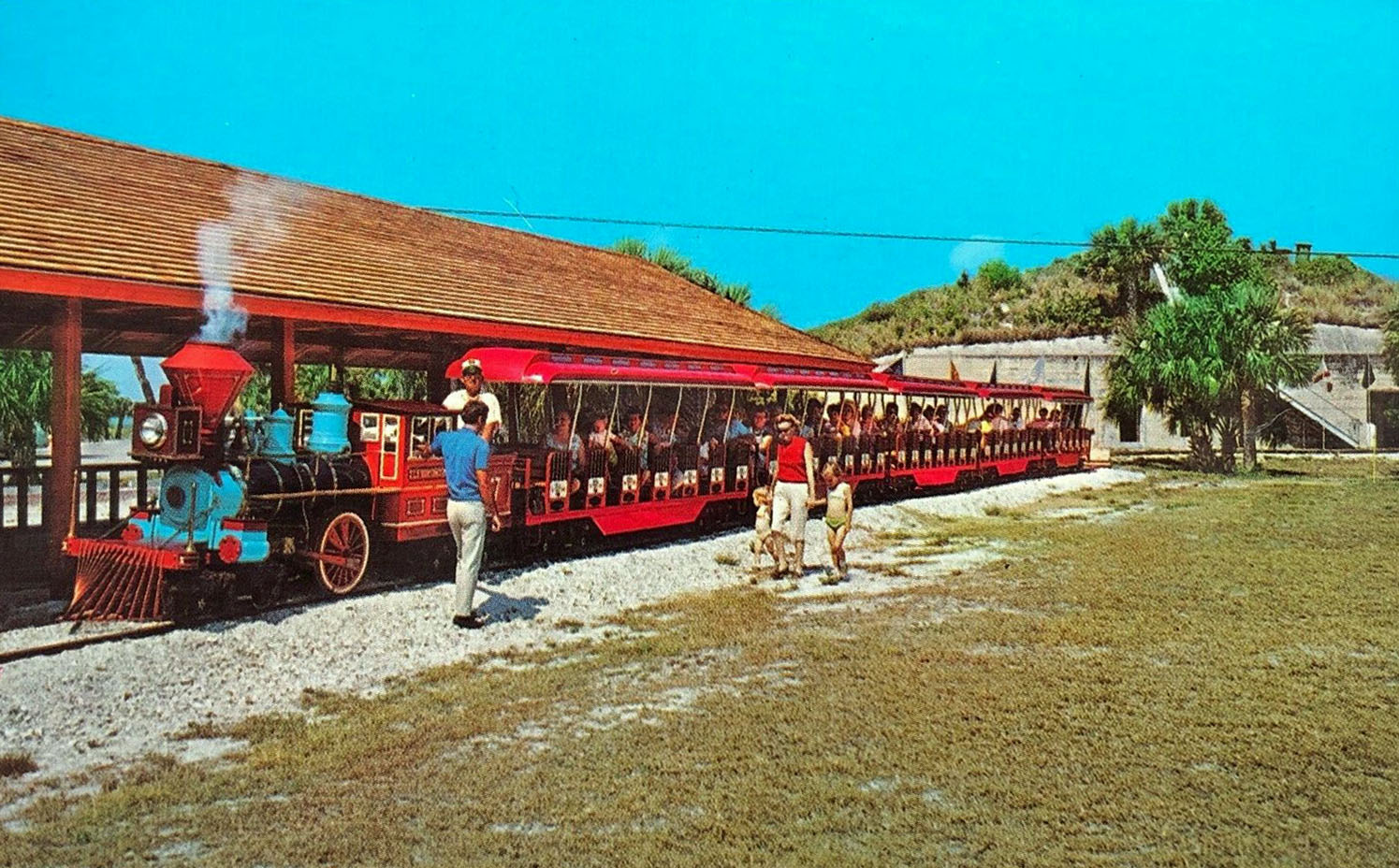

St. Petersburg Times, May 12, 1963.
Actor Henry Fonda, lured to the area with the promise of a day’s tarpon fishing, gave a short speech at the Fort De Soto Park dedication ceremony on May 11, 1963. Guy Lombardo and His Royal Canadians performed, and 13 local girls competed for the title of Miss Fort De Soto, afterwards posing for photos with an uncomfortable-looking Fonda. There was a waterski show, direct from Cypress Gardens, to hold the interest of the estimated 15,000 locals gathered on yet another miserably hot Saturday afternoon.
Fonda, for reasons lost to memory, arrived with a handful of dirt from Wyoming, site of his most recent film, Spencer’s Mountain. While news cameras clicked, he poured the soil into a silver chalice, where it was ceremoniously mixed with beach sand, along with what was described as “sand from Spain” by a re-enactor dressed as 16th century Spanish explorer Hernando de Soto, namesake of the park.
Fort De Soto, in reality, had about as much to do with the Spanish, and de Soto himself, as it did with Henry Fonda and his latest box office hit.
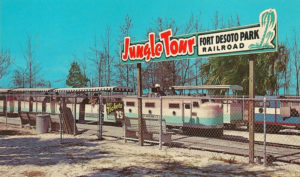
In the early 1960s, there was another train at Fort De Soto. This one zipped through the scrub palmetto and mangroves. the “wild” areas across the main road from the fort. Postcard image.
Every St. Petersburg kid since 1962 (when the first toll road opened) has fond memories of Fort De Soto, a 1,000-acre water-and-woodland park on Mullet Key, the southernmost barrier island off the Pinellas coast. The county acquired the property in 1948 from the U.S. Army Air Corps, which had been using it as a test-bombing range during World War II.
It remains the wildest place in Pinellas, with none of the skyscraping condominiums or other signs of human expansion that spread like fungus over nearby Tierra Verde. It is the domain of raccoons, wading birds, seagulls and sunburned tourists. The kiddie train rides, the beauty pageants, the pomp and the circumstance are long gone; otherwise Mullet Key, and Fort De Soto, look almost exactly as they did the day the park first opened. In Florida, that’s saying a lot.
The public beach at Fort De Soto is considered one of the best in the state, if not the entire country. In 2009, Trip Advisor named it America’s Top Beach.
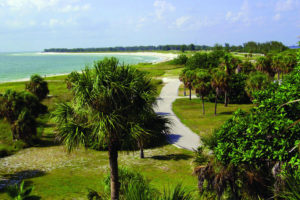
Looking north from the top of Fort De Soto. Pinellas County Parks.
The beach was always the draw, of course, but in earlier times it had been accessible only by boat. With the coming of the bridge and the public park and Henry Fonda and Guy Lombardo, the expansion of the campgrounds and the construction of a snack bar and a gift shop, Fort DeSoto became part of the “Holiday Isles,” Pinellas County’s beach-vending marketing blitzkrieg. The door was opening wide for tourists.

Mortars at Battery Laidley. Photo by Bill DeYoung.
At the heart of the park stand the decaying remains of Fort De Soto itself, constructed by the Army between 1898 and 1900. In truth, what every visitor sees – and every easily-impressed local kid vividly remembers – is what’s left of Battery Laidley, which housed eight 12-inch mortars, guns that could fire shells up to seven miles. Four of these massive weapons, long since deactivated, are still there.
A series of roughshod artillery and storage rooms constructed from a mixture of seashells, sand and concrete – the walls were between eight and 20 feet thick – Battery Laidley was camouflaged behind a mountain of carefully-placed sand and vegetation, so that enemy ships attempting to enter Tampa Bay, and surprise the all-important Port of Tampa, would not know the Fort, and its guns, were waiting for them.
The Spanish-American War was over in less than a year, and although the resident soldiers conducted numerous drills, lobbing shells at a target towed behind one of their own ships, the fort’s guns were never fired at an enemy.
There were, to be sure, enemies everywhere:
The suffering of the men daily at work or drill has been greater than can be imagined by any who have not actually experienced it. There have been nights that the men have had no sleep due to mosquitoes in quarters, even though mosquito bam (nets) are used. At present, life for the men is a torture both night and day, and the mosquitoes have to be fought with a bush continuously whether at work or resting.
Post quartermaster’s report, 1908
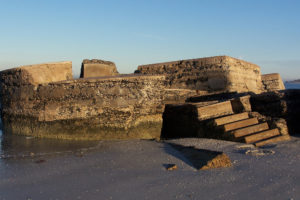
The ruins of Battery Bigelow. Pinellas County Parks.
A second, smaller battery was installed closer to the beach, which allowed a tighter mortar trajectory into bay waters. Erosion has taken a toll on Battery Bigelow, however, and only a few crumbling concrete footers and chunks of wall remain.
Indeed, there’s virtually nothing left of the actual Fort De Soto military post, which featured 29 wooden buildings including barracks for the 125 troops, offices, stables, a kitchen and mess hall, a bake house and nice homey quarters for officers and their families.
It’s less commonly known that Fort De Soto had a twin, approximately two miles southwest as the pelican flies, on Egmont Key. Fort Dade (named for Major Francis L. Dade, killed in the Second Seminole War) actually housed more soldiers (about 250) and included a tennis court, baseball, bowling, a gymnasium and a movie theater.
Because it’s never been accessible by car, Egmont Key has remained off the beaten tourist track. The 328 acres of sand and scrub is overseen by the Florida Park Service, and because of its importance as a seabird nesting site, it’s also a National Wildlife Refuge. A good part of the island is off-limits to visitors.

The ruins of the mortar batteries at Ford Dade, across the shipping channel from Fort De Soto on Egmont Key. Florida State Parks.
Its location at the mouth of Tampa Bay made Egmont a strategic navigational hub for centuries (the first lighthouse was erected in 1848). During the Civil War, it was home base for Union soldiers fearing Confederate blockade runners. It also has historical significance as the site of an internment camp for Seminole Indians. The Tampa Bay Pilots Association, which discharges local pilots to navigate incoming cargo ships safely through Tampa Bay, runs a way station on the island.
What’s key about Egmont Key is that it was, and is, adjacent to the historical shipping channel, the only way for larger vessels to enter the bay, and reach the port. Any enemy ship – Confederate, Spanish or otherwise – had to pass directly between Egmont and Mullet Keys to get to the centers of commerce and population.
With Fort De Soto on the north side of the channel, and Fort Dade on the south, the bay, the port, the cities and the citizens would be protected.
Of course, protection was never necessary, and both Fort De Soto and Fort Dade were decommissioned; both were completely abandoned by the military in the early 1920s.
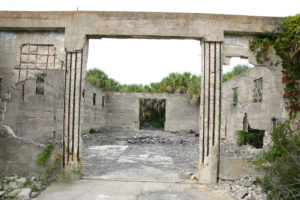
Fort Dade ruins. Florida State Parks.
Although Fort De Soto came back to life as a recreational area, before and after its rekindled military use in the ‘40s, the more remote Fort Dade was allowed to fall into disrepair; indeed, as Egmont’s western coast has eroded, many of the battery buildings have crumbled and/or disappeared beneath the green Gulf waters.
Battery Laidley was listed in the National Register of Historic Places in 1977. Two of Fort Dade’s rusting 17-ton mortars were “rescued” in 1980, cleaned up and put on display at the Fort De Soto site.

A 17-ton, 6-inch Rapid Fire Armstrong Rifle from Fort Dade, recovered and relocated to Fort De Soto in 1982. Photo by Bill DeYoung.
Private boats visit Egmont Key with regularity – the areas that are open to the public – with visitors exploring the ruins of Fort Dade and enjoying one of the area’s most pristine and unspoiled beaches. A ferry from the Fort De Soto dock makes one or two trips over per day, depending on the season.
By contrast, it’s estimated that Fort De Soto welcomes between 2 and 3 million people per year. Which is pretty good, considering Henry Fonda, who died in 1982, never came back.
Information on Fort De Soto Park
Information on Egmont Key/Fort Dade
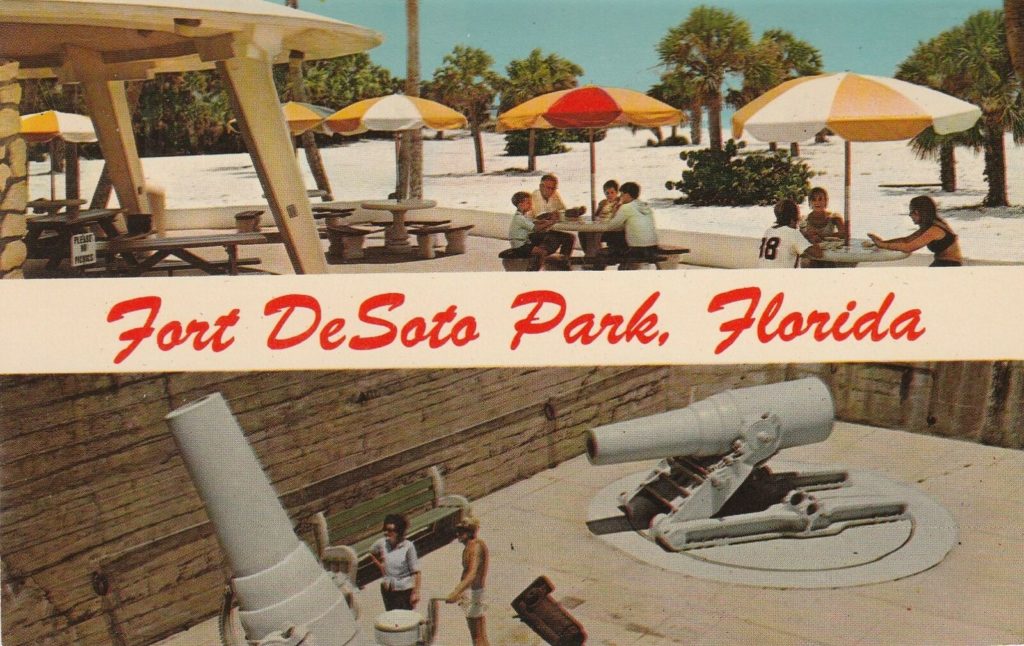




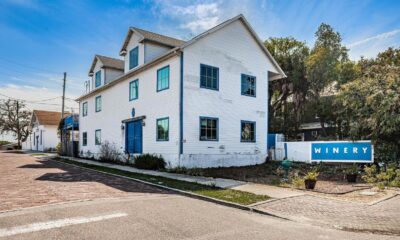



Marlene J. Miller
February 18, 2023at1:09 am
As a kid I loved going to the fort what a very interesting place. The beach fabulous.
jon
January 3, 2023at12:37 pm
Long before there was a bridge to Ft Desoto, we used to camp in the WWII Spotting Towers that lined the seward side of the island.